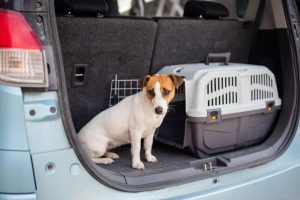5 Easy Ways to Keep Your Dog Safe In The Car While Traveling

How to secure your dog in the car
Securing your dog in the car is a crucial step in ensuring their safety and preventing potential accidents. Several options are available, each with its own advantages and considerations. It’s essential to choose the method that best suits your dog’s size, temperament, and your vehicle’s layout.
Understanding the different dog car safety options
When securing your dog in the car, there are various options available, each with its advantages and considerations. Understanding these options will help you make an informed decision that best suits your needs and your furry companion’s safety.
Dog Car Harnesses and Seat Belts:
These specialized harnesses are designed to secure your dog to the vehicle’s seat belt system. They come in different sizes to accommodate dogs of various breeds and weights. Proper fit is crucial to ensure your dog’s safety and prevent escape or injury during sudden stops or collisions.
Dog Crates and Carriers:
Sturdy crates or carriers can be secured in the cargo area or on the back seat, providing a comfortable and familiar space for your dog during the journey. They offer excellent containment and protection, especially for anxious or excitable dogs.
Pet Barriers and Dividers:
These barriers separate the cargo area from the passenger compartment, preventing your dog from entering the front seats and causing distractions. They are particularly useful for larger vehicles or SUVs with ample cargo space.
Dog Hammocks and Seat Covers:
While not primarily designed for safety, these products can help create a comfortable and secure space for your dog in the back seat or cargo area. They protect your vehicle’s upholstery and provide a non-slip surface for your furry companion.
Dog Travel Beds and Mats:
Specially designed travel beds or mats can provide your dog with a cozy and secure spot during the journey. They often feature non-slip surfaces and raised edges to prevent your dog from sliding around.
When choosing the right option, consider factors such as your dog’s size, temperament, and the type of vehicle you drive. It’s also essential to gradually introduce your dog to the restraint system and provide positive reinforcement during the process.
Tips for buckling your dog in the car
Buckling your dog in the car is a crucial step in ensuring their safety and preventing potential accidents. Here are some tips to help you do it effectively:
- Choose the Right Restraint System: Select a restraint system appropriate for your dog’s size, weight, and temperament. Depending on your preferences and your dog’s needs, consider using a dog car harness, seat belt, or crate.
- Proper Fit is Key: Ensure that the restraint system fits your dog snugly but comfortably. A loose or ill-fitting harness or seat belt can be ineffective and potentially dangerous in the event of a sudden stop or collision.
- Introduce Gradually: If your dog is new to being restrained in the car, introduce the process gradually. Start by letting them explore the restraint system at home, offering treats and praise for positive behavior. Then, progress to short car rides before attempting longer journeys.
- Use Positive Reinforcement: Reward your dog with treats, praise, and affection when they remain calm and relaxed while restrained in the car. This will help them associate the experience with something positive and reduce any anxiety or stress.
- Secure Properly: Follow the manufacturer’s instructions carefully when securing the restraint system. Make sure it is properly anchored to the vehicle’s seat belt system or secured in the designated area.
- Adjust as Needed: During the journey, periodically check on your dog and make any necessary adjustments to ensure their comfort and safety. If they seem distressed or the restraint system has shifted, pull over and address the issue.
- Never Leave Your Dog Unattended: Never leave your dog unattended in the car, even if they are restrained. Extreme temperatures can quickly become dangerous and potentially life-threatening for your furry companion.
By following these tips and being patient and consistent, you can help your dog become comfortable and secure while traveling in the car, ensuring a safe and enjoyable journey for both of you.
Creating a safe and comfortable space for your dog in the car
While securing your dog in the car is essential for their safety, it’s also important to create a comfortable and familiar environment for them during the journey. Here are some tips to help you achieve this:
- Bring Familiar Items: Pack your dog’s favorite toys, blankets, or bedding to create a cozy and familiar space in the car. The familiar scents and textures can help reduce anxiety and make them feel more at ease.
- Provide Water and Snacks: Keep a spill-proof water bowl and some healthy snacks within reach. Staying hydrated and having occasional treats can make the journey more enjoyable for your furry companion.
- Use Calming Aids: If your dog experiences anxiety or stress during car rides, consider using calming aids such as pheromone diffusers, calming music, or natural supplements (after consulting with your veterinarian).
- Offer Potty Breaks: Plan frequent stops to allow your dog to stretch their legs, relieve themselves, and burn off some energy. This can help prevent accidents and reduce restlessness during the journey.
- Provide Ventilation: Ensure proper ventilation in the car to maintain a comfortable temperature and prevent overheating or nausea. You can crack the windows or use the air conditioning system, depending on the weather conditions.
- Use Seat Covers or Hammocks: Invest in high-quality seat covers or hammocks designed specifically for dogs. These can protect your vehicle’s upholstery from dirt, hair, and potential accidents, while also providing a non-slip surface for your furry companion.
- Consider Crate Training: If your dog is crate-trained, using a crate in the car can provide a familiar and secure space for them during the journey. Make sure to introduce the crate gradually and make it a positive experience.
Creating a safe and comfortable environment for your dog in the car can reduce their stress levels and ensure a more enjoyable travel experience for both of you.
The safest place for your dog in the car
When it comes to your dog’s safety in the car, choosing the right location is crucial. Different areas of the vehicle offer varying levels of protection and potential risks. Here’s a breakdown of the safest places for your furry companion:
- Back Seat: The back seat is generally considered one of the safest places for your dog in the car. It provides a buffer zone between your dog and the front seats, reducing the risk of injury in the event of a collision or sudden stop. Additionally, it keeps your dog away from the potential hazards of the front airbags.
- Cargo Area: The cargo area can be a suitable option for larger vehicles like SUVs or wagons, especially when equipped with a pet barrier or divider. This space separates your dog from the passenger compartment, preventing them from becoming a distraction or projectile in case of an accident.
- Crate or Carrier: Using a sturdy crate or carrier secured in the back seat or cargo area is another safe option. These enclosed spaces provide excellent containment and protection for your dog, minimizing the risk of injury during sudden movements or collisions.
- Front Seat (Not Recommended): While some pet owners may be tempted to have their dog in the front seat, this is generally not recommended. In the event of a collision, the force of the airbag deployment can be extremely dangerous for your furry companion, potentially causing severe injuries or even fatalities.
How to secure your dog in the car with a leash
One of the simplest and most effective ways to secure your dog in the car is by using a leash or harness attached to a secure anchor point. This method prevents your pet from roaming freely inside the vehicle and minimizes distractions for the driver.
To secure your dog with a leash, follow these steps:
- Choose a sturdy, well-fitting harness or collar designed for car travel. Avoid using a standard collar, as it can put pressure on your dog’s neck during sudden stops or turns.
- Identify a secure anchor point in your vehicle, such as a latch bar or a seat belt attachment point. If you are unsure, consult your vehicle’s owner’s manual or seek professional advice.
- Attach the leash or harness to the anchor point, ensuring it is securely fastened and allows enough length for your dog to sit, stand, or lie down comfortably without becoming tangled or choked.
- Adjust the leash or harness length to prevent your dog from reaching the front seats or interfering with the driver’s controls.
- Consider using a dog seatbelt or harness designed specifically for car travel. These provide additional safety features and distribute forces more evenly in case of an impact.
Remember, never attach the leash or harness to a part of the vehicle that could break or come loose during an accident, such as a headrest or armrest. Additionally, ensure your dog is properly secured before starting your journey and avoid allowing them to roam freely while the vehicle is in motion.
Is it safe to let your pet look out the passenger window while driving?
Allowing your dog to look out the passenger window while driving is not a safe practice. While it may seem harmless, there are several risks associated with this behavior.
- Distraction for the driver: A dog hanging out the window can be a significant distraction for the driver, increasing the risk of accidents. Your pet’s movements, barking, or attempts to jump out can divert the driver’s attention from the road.
- Potential injuries: If your dog hangs out the window, there is a risk of injuries from flying debris, insects, or even branches from trees or other vehicles. Additionally, sudden stops or turns can cause your pet to be thrown against the window or door frame, leading to injuries.
- Ejection from the vehicle: In the event of a collision or sudden maneuver, an unsecured dog hanging out the window could be ejected from the vehicle, resulting in severe or fatal injuries.
- Obstructed visibility: A dog hanging out the window can obstruct the driver’s view, making it difficult to see pedestrians, other vehicles, or potential hazards on the road.
Instead of allowing your dog to look out the passenger window, securing them properly using a crate, harness, or other approved restraint system is recommended. This not only protects your pet but also ensures the safety of everyone in the vehicle and other road users.
Where should I put dog car accessories?
When it comes to dog car accessories, proper placement is crucial for both safety and convenience. Here are some recommendations on where to position various accessories:
- Dog crate or carrier: The safest location for a dog crate or carrier is in the cargo area or the back seat of your vehicle. Secure the crate or carrier with a seatbelt or other anchoring system to prevent it from sliding or tipping over during sudden stops or turns.
- Dog harness or seatbelt: If you’re using a dog harness or seatbelt, the ideal location is in the back seat of your vehicle. Ensure the harness or seatbelt is securely attached to a designated anchor point, such as a latch bar or seat belt attachment.
- Dog barrier: A dog barrier is designed to separate the cargo area from the passenger compartment. Install the barrier securely behind the rear seats, ensuring it doesn’t obstruct the driver’s view or interfere with the operation of the vehicle.
- Dog ramp or step: For larger dogs or those with mobility issues, a ramp or step can be placed at the rear door or tailgate to facilitate easy entry and exit from the vehicle. Ensure the ramp or step is sturdy and stable before use.
- Dog travel bowls: Keep travel bowls for water and food in an easily accessible location, such as the cargo area or the back seat. Avoid placing them in areas where they can spill or become a projectile in case of sudden stops or turns.
- Dog toys and treats: Store dog toys and treats in a secure container or bag, preferably in the cargo area or under a seat, to prevent them from rolling around and becoming a distraction or hazard.
Remember, the safety of your dog and the vehicle occupants should be the top priority when placing dog car accessories. Always follow the manufacturer’s instructions and secure all accessories properly to prevent them from becoming projectiles in case of an accident.
How to secure a dog in the cargo area of an SUV
Securing your dog in the cargo area of an SUV (Sport Utility Vehicle) is a safe and practical option, especially for larger breeds or multiple dogs. Here are the steps to follow:
- Use a crate or carrier: The safest way to secure your dog in the cargo area is by Ensure the crate is securely anchored to the cargo area using straps or other anchoring systems provided by the manufacturer.
- Install a cargo area barrier: If you prefer to allow your dog to move freely in the cargo area, consider installing a cargo area barrier or divider. These barriers separate the cargo area from the passenger compartment, preventing your dog from entering the cabin and distracting the driver.
- Use a dog harness or seatbelt: For added safety, you can secure your dog within the cargo area using a harness or seatbelt designed specifically for pet travel. Attach the harness or seatbelt to designated anchor points in the cargo area, allowing your dog enough room to move comfortably but preventing them from being thrown around in case of sudden stops or collisions.
- Provide comfortable bedding: Make the cargo area comfortable for your dog by placing a soft, non-slip mat or bedding. This will help prevent injuries and keep your dog calm during the journey.
- Ensure proper ventilation: SUV cargo areas can get hot and stuffy, especially during warm weather. Open windows or use the vehicle’s climate control system to circulate air into the cargo area.
- Secure loose items: Remove or secure any loose items in the cargo area that could potentially harm your dog or become projectiles in case of an accident.

Remember, never leave your dog unattended in a parked vehicle, especially during hot or cold weather conditions, as this can be extremely dangerous and potentially life-threatening.
How long can a dog sit in a car?
The amount of time a dog can safely sit in a car depends on various factors, such as the weather conditions, the dog’s age and health, and the availability of proper ventilation and temperature control inside the vehicle. Here are some general guidelines:
- Short trips (up to 2 hours): Most healthy dogs can comfortably sit in a well-ventilated car for up to 2 hours, provided the temperature inside the vehicle is moderate and they have access to water.
- Longer trips (2-6 hours): For longer trips, it’s recommended that you take breaks every 2-3 hours to allow your dog to stretch their legs, relieve themselves, and hydrate. Ensure the vehicle is well-ventilated and the temperature is comfortable for your pet.
- Extended periods (more than 6 hours): Leaving a dog in a car for more than 6 hours is generally not recommended, even with proper ventilation and temperature control. Dogs can become anxious, restless, and prone to dehydration or heat-related illnesses if confined for too long.
It’s important to note that certain factors can significantly reduce the safe duration for a dog to sit in a car:
- Hot or cold weather: Extreme temperatures, whether hot or cold, can quickly become dangerous for dogs left in a vehicle, even with the windows cracked open. Heatstroke and hypothermia are serious risks.
- Puppies and senior dogs: Puppies and senior dogs may have a harder time regulating their body temperature and may need more frequent breaks and access to water.
- Brachycephalic breeds: Breeds with short snouts, such as Pugs or Bulldogs, are more susceptible to respiratory issues and may have difficulty coping with prolonged confinement in a vehicle.
- Pre-existing health conditions: Dogs with certain medical conditions, such as heart or respiratory problems, may not tolerate extended periods in a car as well as healthy dogs.
If you need to leave your dog in the car for an extended period, it’s best to have someone stay with them or find an alternative, such as a pet-friendly establishment or a dog daycare facility. Always prioritize your dog’s safety and well-being when making decisions about leaving them in a vehicle.
How to safely leave your dog in the car
While leaving your dog unattended in a car is generally not recommended, there may be situations where it’s unavoidable for a short period. If you must leave your dog in the car, follow these safety guidelines:
- Park in a shaded area: Choose a shaded parking spot or use a sunshade to keep the interior of the car cooler and protect your dog from direct sunlight.
- Provide adequate ventilation: Leave the windows partially open (at least a few inches) or use the vehicle’s climate control system to ensure proper air circulation and ventilation.
- Offer water and treats: Leave a bowl of fresh water and some treats or toys to keep your dog hydrated and occupied during your absence.
- Use a crate or secure restraint: If possible, confine your dog in a well-ventilated crate or secure them with a harness or seatbelt to prevent them from moving around the vehicle or becoming a distraction to passersby.
- Avoid extreme temperatures: Never leave your dog in a parked car during hot or cold weather conditions, as the temperature inside the vehicle can quickly become dangerous, even with the windows cracked open.
- Set a timer: Set a timer or alarm to remind you to check on your dog regularly and return as soon as possible.
- Leave a note: Place a note on the dashboard or window indicating the time you left and your contact information in case someone becomes concerned about your dog’s well-being.
- Consider alternatives: If you anticipate being gone for an extended period or if the weather conditions are not suitable, explore alternatives such as leaving your dog at home, taking them with you, or finding a pet-friendly establishment.
*Article updated on July 22, 2024




